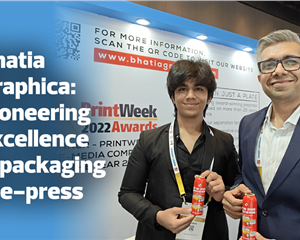IP-APPM is only now getting the credit it deserves for the success as a paper company that is among the largest in India. Priya Raju meets Rampraveen Swaminathan, chairman and managing director at IP-APPM in Hyderabad. Later she travels to Rajamundhry, Kadiyam, Mulugapudi, SR Peta in Andhra Pradesh to investigate the manufacturing sites, forestry and wood depots
Priya Raju (PR): Let’s start with your background. What prompted you to join the paper industry?
Rampraveen Swaminathan (RS): I was based in the USA prior to joining International Paper (IP). There, I was working with Cummins Power Generation, heading their global power systems business. My family wanted to move back to India and it was at the same time International Paper was entering the Indian market. There was an opportunity which translated into growth and thus my first tryst with the paper industry started. The journey has been interesting, so far.
PR: What are the key elements of change that you have observed in your journey in the paper industry?
RS: Globally, the industry has its own challenges in terms of sustainability. As an industry we consume a lot of natural resources and our challenge is in doing it without affecting the environment and not depleting it. And this translates into having sound business practices and environmental standards and so on.
The other challenge is substitution. With the increase in digitisation, the demand for traditional paper has reduced and is eating into the share of paper. The printing paper business continues to be under pressure across the world and has been low or negative growth in most geographies of the world.
Due to this, a lot of paper manufacturing companies are reinventing. At International Paper, we chose to respond by increasingly focusing more on the packaging sector which has been growing organically and inorganically. Our focus is on segments such as industrial packaging, consumer packaging. This is true in India as well.
PR: What are the trends in the Indian market?
RS: The Indian market for paper and packaging continues to grow in almost all grades of paper like tissues, industrial packaging, etc. India has a conducive environment and better growth outlook than most other countries. However, in the last few years growth has slowed down, especially for printing papers.
However, the industry is facing headwinds. Domestic fiber cost has gone up substantially, plus the Rupee has depreciated which has impacted fuel rates and items. Imported recycled paper costs have also been impacted by the depreciating rupee. Supplies have also increased due to capacity additions and increased imports.
To summarise, the last 2-3 years has been stormy for us as an industry. But things are improving now. Tough environments make us more focused on deliberate improvements, which has been our focus as well.
PR: In the midst of all these issues, why did IP decide to invest in India?
RS: At IP our market view has always been long term. IP for the past 10-15 years has been globalising across the world. And India is a point in the journey. We have also invested in industrial packaging portfolio in North America as well. We tend to take the view of multiple businesses and value creation from a longer term horizon.
Plus, investing in IP-APPM was a first step towards developing a base in India. India is a tough market, but there is upside and growth potential in paper and packaging.
PR: What are the trends you are observing with respect to the various business segments of paper?
RS: Indian industry has around 13 million tonnes of capacity. 4.2 million is uncoated free sheets which comprise of writing paper and 6.5 million tonnes of packaging grades – kraft liner, testline and coated paper board. Rest comprises of newsprint, tissue and speciality papers.
PR: Can you share your view about the growth rate in different segments?
RS: According to our estimates, the industrial corrugated packaging is growing at approximately 7-8%. Of the total, the uncoated free sheets will grow at 4-5%. Demand growth varies based on the macroeconomic environment as well as specific segments. Textbook segment has been slow, but notebooks are growing at a reasonable rate, and demand for cut size paper has been growing at a robust rate of 10-12% per annum.
PR: Most of the paper price hikes have been sudden. How does IP announce this?
RS: Like any industry, we are also impacted by inflationary trends. In the past few years, wood has doubled and other commodities have also gone up. At International Paper, we are focused on linking pricing to the value proposition provided by our products. We price our products based on the value, features and technical benefits of the paper. Thus the pricing approach for different grades of paper is different.
Our main customers are our distributors who then sell to end customers such as printers, where we are involved mainly in technical support. To our distributors, we offer a structured pricing process – both price increases and reductions.
PR: Is the India print market open for value added products at a premium price?
RS: I think the print industry today is extremely knowledgeable. If I can go and show the printer that here is the incremental and marginal value you can get; I don’t think there is any reason for a printer to say no. With whomever we have shared this; they have been positive about this and even our distributors have been engaged in this process.
It has to be win-win and not win-lose; if you charge an extra rupee you will have to explain why. I believe Indians are the most sophisticated buyers in the world and incredibly good at recognising value.
PR: What is the contribution of exports? Also, how does IP manage its sales function across geographies and segments?
RS: 75% of our total sales is from the domestic market and 25% contribution is from exports. In the domestic market, around 25% of our product base is stock and sell. In exports, we don’t have trading partners/merchants, but we have appointed few distributors, who hold stock.
A small part of the domestic market business is managed directly through large accounts which constitute of customers from notebooks and publication space. Most of our domestic business is largely through distributors and we provide technical sales support. We go and work with distributors and various accounts and continuously strive to make our paper better. We have a different sales teams for domestic and exports markets.
Many distributors in the Indian paper industry deal with multiple brands and hence we work on how to sell differently and create a brand value.
PR: Digital printing is growing at a rapid pace, how do you plan to cater to the digital print industry?
RS: To be honest we are still evaluating our options. Some of the products that we currently produce find application in digital, but not much. Volumes are still in offset and web.
PR: What movements do you see in sheetfed offset and web offset?
RS: There has been an advent of digitisation and digital learning, but there is still a fundamental need of notebooks. For example, when you consider the Sarva Shiksha Abhiyaan initiative by our government, it is not as big as it was few years ago. The volume and funding priorities have changed and it’s declining.
But, education sector in terms of notebooks has shown an increase in demand. As far as the cut-size paper market, service industry and to some extent education sector is concerned, it is growing. People prefer having a notebook. Also, the photo-copying industry is huge and this is one market that has continued to grow rapidly.
Pure publishing grades continue to grow under pressure, as there is an increasing risk of substitution for traditional materials. Earlier invariably every sales person would carry a printed brochure and sales literature, but those numbers are clearly coming down today.
PR: How can one adapt to such changes?
RS: For every industry, it depends on how you are positioned to cater to the market. For example, volumes for posters are declining, but at the same time, there is still a huge demand for religious calendars. Grades such as paper for notebooks or cut size are growing so we need to develop capabilities to meet customer needs in those segments.
As the delivery system changes, the way people consume paper changes. Hence, substitution does not necessarily result in zero demand. As an industry, we have to figure out such change and adapt.
PR: What are the new segments IP is focussing on?
RS: Right now in India our focus is on paper and packaging. On the paper side, our focus is to optimise our business and the way we lead ourselves. We are continuing to evaluate entry into the containerboard market.
Food service is a growing market in India and it will evolve over a period of time. Then there is the retail segment which is growing and so is the fast food segment and there is the cultural driver here. Also, the customer preferences are evolving. Customers are moving towards paper cups, from traditional glasses in the roadside chai tapri.
Changes have started, markets are broadening and demand factor is evolving. I believe these markets will continue to grow. The challenge is how we can provide more innovative solutions and create customer value.
PR: In future, does IP has plans to invest in the conversion for packaging market?
RS: In uncoated freesheet, we don’t aim to expand further into the conversion market in India as I feel the current players are good enough to cater to the needs, plus the consumption is fragmented. We have invested in capacity for cut size and are making improvements in folio conversion, but there are no additional plans. We have some products for food service where we make some grades for cup stock and bottoms. However, we do not plan to enter extrusion or related conversion. Conversion is a process that we partner with and it will be same for the food packaging. There are a lot of incumbent players with good capabilities.
PR: Any plans for investment in machinery?
RS: Our asset investment strategies are focused on three areas de-bottlenecking, environmental performance and product differentiation. In last three years, we have spent approximately Rs 200 crores for these three initiatives.
We have invested in state-of-the-art sheeter for cut-size paper with a capacity of 90,000 MTPA. We have also made investments in de-bottlenecking pulp mills. As part of our environmental focus we have set up an effluent treatment plant, sludge press and odour control and dust control equipment. We continue to make such investments.
PR: What are the various initiatives that IP undertakes? One CSR initiative that is close to your heart?
RS: We have a lot of things happening on CSR front. Education, engagement and environment are the areas we are focusing on. We have launched various digital learning programs; we work with various schools etc.
Employee engagement is what is close to my heart. We encourage our employees to go and spend time for various initiatives during office hours. This translates into employees taking ownership of the initiative. It is their community and they take ownership of their city. Most of the time, employees voluntarily follow up on many of the initiatives which are close to their hearts. This is what that matters.
If anyone can take the ownership and work for their own community, then this is a lot more than any kind of philanthropy initiative that we can do. It makes them proud of the company they work for.
PR: What are your thoughts on Government and the policy environment?
RS: We are a highly regulated industry. Frankly, there are few areas where the policies are unclear. For forest-based industries, there is no clear policy and all types of forests are categorised together. The result is, we have the world’s most expensive woods and that impacts the cost structure of the industry. The government should also consider support for the industry on technical and environmental upgradation. There needs to be a lot more imagination to support the industry given the level of employment generated and potential to contribute to initiatives such as “Make in India”.
PR: But there has been a lot of noise in promoting manufacturing in India...
RS: There has been a lot of talk about ease of business. But, frankly, it has still not hit the ground. A process for permits and sanctions still takes four to five years, which is a 50% escalation directly on the cost.
So the government policies should be more helpful in such capital-intensive business. There has to be strict governance for red category industry, but it does not mean that it should be longer in terms of time taken for approvals and grants.
The Andhra Pradesh government has been helpful and constructive, in terms of providing solutions.
PR: Finally, what motivates you to be in this industry?
RS: The interesting factor about our industry is the large and complex supply chain where we deal with farmers who grow our woods to our end customers who use paper for various day to day things.
We are in an industry which has a lot of impact on the environment. But the excitement for me is to be working for a company that takes into account the environmental values and touch lives of people from different walks of life. At International Paper, how we do things is as important as what we do. To create a sustainable business which adds value to all our stakeholders is a great leadership opportunity.
IP-APPM's supply chain strategy
Inbound supply chain: Power and wood form the major part of the raw material. Most of the power used at the mills is self-generated and 100% of our coal procurement is domestic. Most of the wood used is sourced in and around Andhra Pradesh and Telangana, within a radius of 350sq/mt. IP has divided our supply base in two, the woods procured within 100km usually go directly to the mills and beyond 100km, is brought into a depot.
Outbound supply chain: Larger challenges for IP is the outbound supply chain. For example, nearly 70% of IP's sales is outside Andhra Pradesh and Telangana and caters to customers’ right up to North India. Swaminathan says, "customer fragmentation is a challenge". To add to this, Rajahmundry is not on any direct trunk route and the backhaul facilities are very limited and a lot of transhipments to manage. For the last three years, IP is focusing on expanding the wood depot, the last mile supply chain optimisation in terms of improving customer service. "We are waiting to see how the GST tax structure pans out and we probably have to restructure," adds Swaminathan.
IP’s supply chain agenda: In terms of supply chain strategy IP's focus is on optimising the supply chain cost. The company has implemented this by rationalising and working on the turnaround time (TAT) at ports and just in time (JIT) deliveries to the mill.
Our other focus is on reducing the carbon footprint and developing a more “sustainable” supply chain. In a day, over 200 trucks move around locations to collect wood and to the mill. The aim is to make these trucks efficient, reduce the holding time etc.
Farm forestry program
IP-APPM under its Farm Forestry program for clonal plantations has so far planted over 1.75 billion saplings in an area of over 2.52 lakh hectares. Around 55,000 small-scale farmers having marginal, fallow and barren lands are covered under company’s program. IP-APPM’s latest cloning centre is one of the largest Casuarina Clonal Production Centre (CPC) in Mulugapudi village in Vishakapatnam district of Andhra Pradesh. This is the company’s 5th CPC in the country and is spread on 5.4acres and has been divided into has 20 low-cost poly houses, with a charging capacity of 20 lakh cuttings per cycle and one crore clonal production capacity per annum. Local communities, particularly women’s groups are employed and trained to produce these low-cost Casuarina clones. This has positively impacted their livelihood by generating employment.
The centre is equipped with state-of-the-art technology to develop superior clonal saplings which can double the productivity of pulpwood as compared to conventional seedling methods. The company's other four cloning centres are located at Devipuram, Theeda, Diwancheruvu and Jhargumalli in Andhra Pradesh and Telangana.
International Paper also works with Indian Institute of Forest Management (IIFM) in the field of forest sustainability which includes entailing action research, capacity building and academic exchange involving experts and researchers from both International Paper and Indian Institute of Forest Management.















 See All
See All